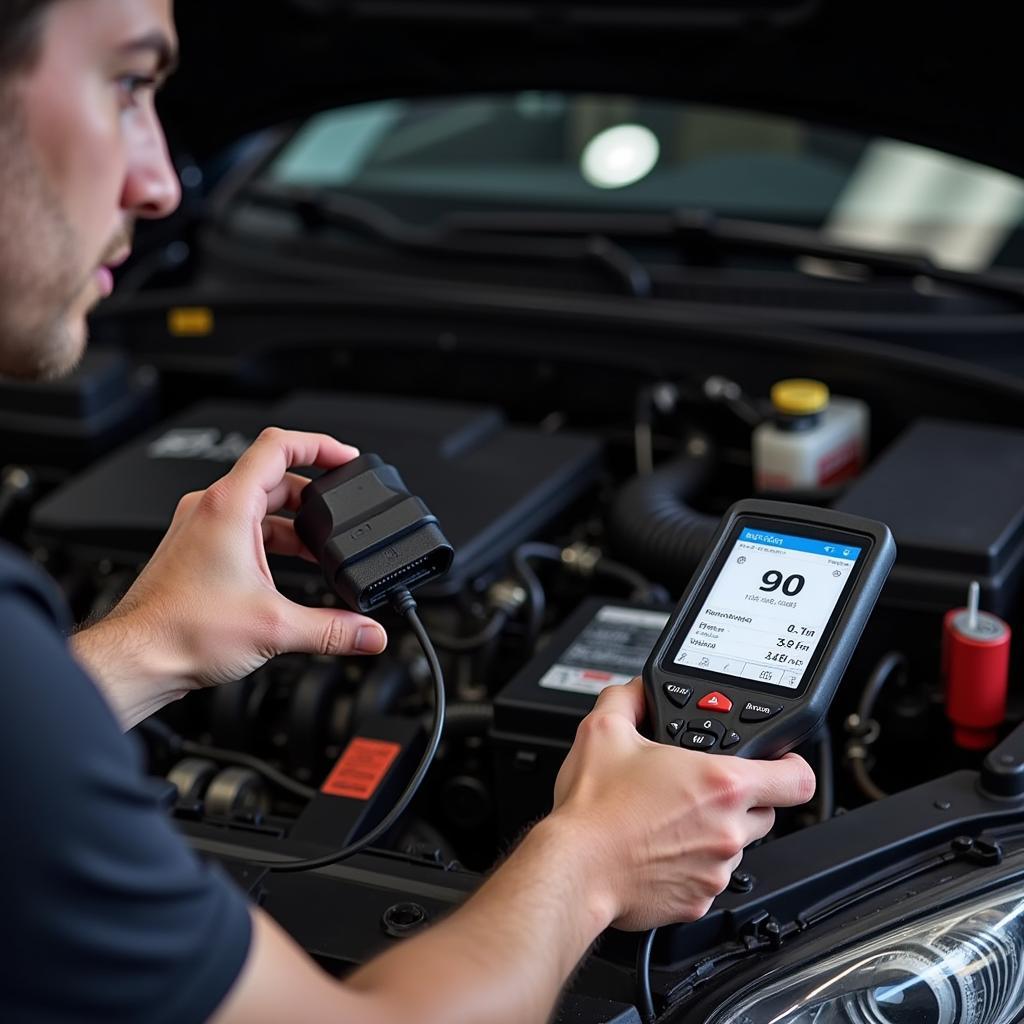Using OBD diagnostics for checking car battery voltage offers a quick and convenient way to assess your battery’s health. This method goes beyond a simple voltmeter reading, providing insights into the charging system and potential issues that might be affecting your battery’s performance. Let’s explore how you can use OBD diagnostics to keep your battery in top shape.
Understanding OBD and Its Role in Battery Voltage Checks
OBD, or On-Board Diagnostics, is a standardized system that allows you to access your car’s computer and retrieve valuable data about its various systems, including the battery. An OBD-II scanner, whether a dedicated device or a smartphone app paired with a Bluetooth adapter, can communicate with your car’s ECU (Electronic Control Unit) and display live data, including battery voltage. Accessing this information allows you to monitor the battery’s voltage under different operating conditions, such as during starting, idling, and driving. This provides a more complete picture of the battery’s health than a static measurement. You can find more information on Bluetooth compatible tools on our page about car diagnostic tools bluetooth.
 OBD Scanner Checking Car Battery Voltage
OBD Scanner Checking Car Battery Voltage
How to Check Car Battery Voltage with OBD Diagnostics
Checking your car battery voltage with OBD diagnostics is straightforward. First, locate your car’s OBD-II port, typically found under the dashboard on the driver’s side. Next, connect your OBD-II scanner. Turn the ignition key to the “on” position (without starting the engine). The scanner will power on and establish communication with the ECU. Navigate to the “live data” or “data stream” section on your scanner. Find the parameter for battery voltage, which is usually displayed in volts (V). Record the voltage reading.
Interpreting the OBD Battery Voltage Readings
Interpreting the voltage readings requires understanding a few key values. A fully charged battery typically reads around 12.6 volts. A voltage reading between 12.4 and 12.6 volts suggests a healthy battery. A reading below 12.4 volts indicates a low charge, potentially requiring a recharge or replacement. If your readings are consistently low, you might want to consider an android car diagnostic kit for regular monitoring.
Why Check Battery Voltage with OBD Diagnostics?
Why use OBD diagnostics when you can use a voltmeter? OBD provides more dynamic information. You can see how the voltage fluctuates during different operating conditions, providing a more accurate diagnosis of potential problems within the electrical system. Furthermore, you can monitor the charging system’s performance. If the voltage doesn’t increase when the engine is running, it could point to a faulty alternator. Additionally, some advanced OBD scanners can display other battery-related data, such as the battery’s state of charge and temperature, providing a comprehensive overview of your battery’s condition. Need professional assistance? A car diagnostic centurion service can provide expert diagnostics and solutions.
Beyond Voltage: Other OBD Data for Battery Health
While voltage is a crucial indicator, OBD can also reveal other vital information about your battery’s health. Monitoring the charging system voltage while the engine is running can pinpoint issues with the alternator or voltage regulator. Some OBD scanners can access the battery’s state of health (SOH), a valuable metric that represents the battery’s remaining capacity. Finally, the battery’s temperature can also be monitored through OBD. Extreme temperatures can significantly impact battery performance and lifespan.
Common Issues Revealed by OBD Battery Diagnostics
OBD diagnostics can uncover several common battery-related issues. A consistently low voltage reading indicates a discharged battery or a charging system problem. Fluctuating voltage while driving can signal a loose connection or a failing alternator. A low charging system voltage with the engine running confirms a faulty alternator or voltage regulator. If you’re experiencing issues with your Delphi diagnostic tool, you can check our troubleshooting guide on delphi diagnostic not working not reading car ecm.
Conclusion: OBD Diagnostics – Your Key to Battery Health
Utilizing OBD diagnostics for checking car battery voltage offers a deeper understanding of your battery’s condition and the overall health of your vehicle’s electrical system. This accessible and powerful tool allows you to proactively address potential issues, ensuring reliable starts and optimal performance. By incorporating regular OBD checks into your car maintenance routine, you can prolong your battery’s lifespan and avoid unexpected breakdowns.
FAQ
- What is the ideal car battery voltage? Around 12.6 volts.
- Can I use my smartphone for OBD diagnostics? Yes, with a compatible OBD-II adapter.
- What does a low battery voltage reading indicate? A discharged battery or a charging system problem.
- What is the purpose of an alternator? To recharge the battery while the engine is running.
- How often should I check my car battery voltage with OBD? Monthly, or more frequently if you suspect issues.
- Can OBD diagnostics detect a failing alternator? Yes, by monitoring the charging system voltage.
- Where can I find the OBD-II port in my car? Usually under the dashboard on the driver’s side.
Need help with car diagnostics? Contact us via WhatsApp: +1(641)206-8880 or Email: [email protected]. Our 24/7 customer support team is ready to assist you.

